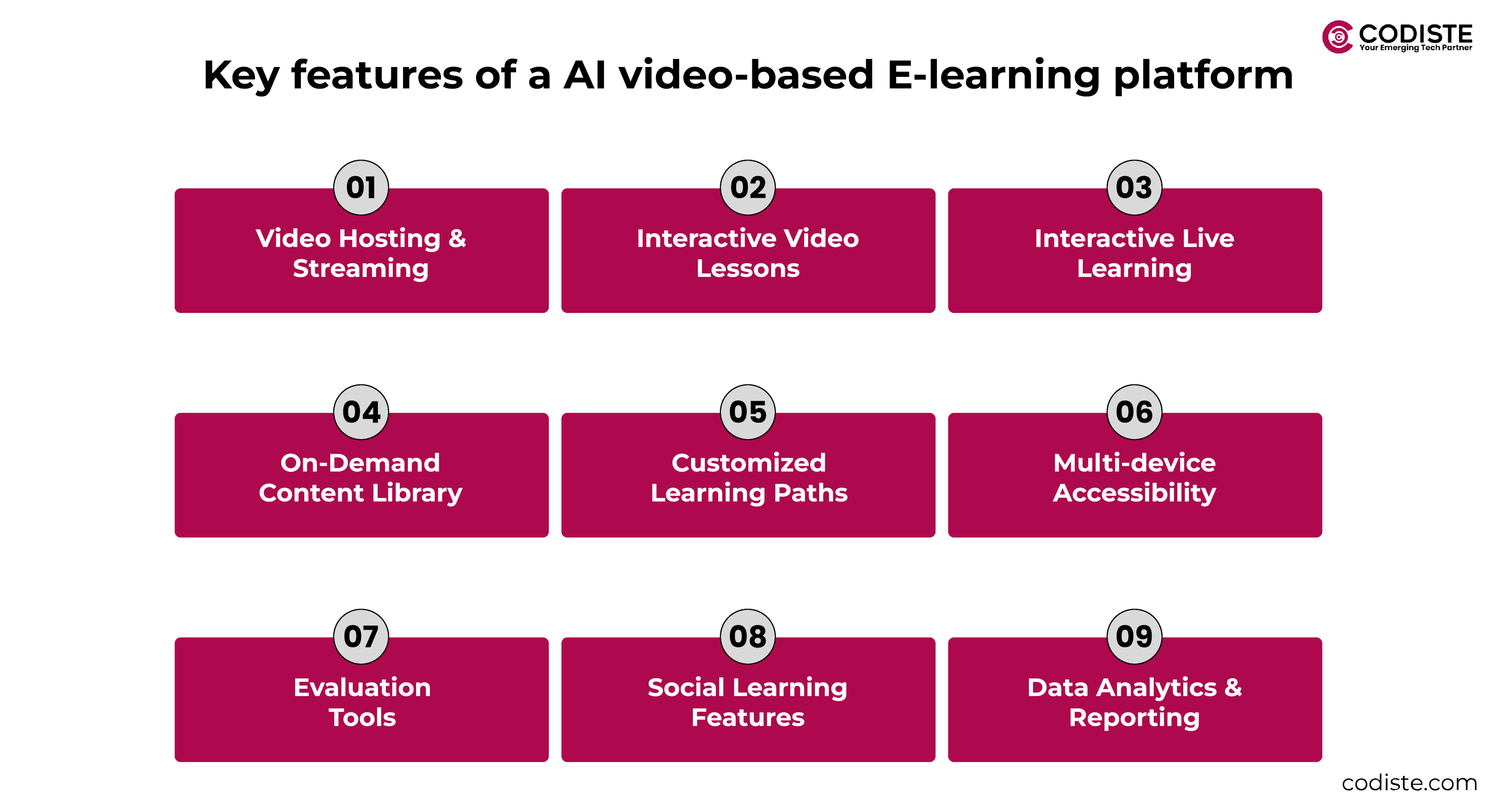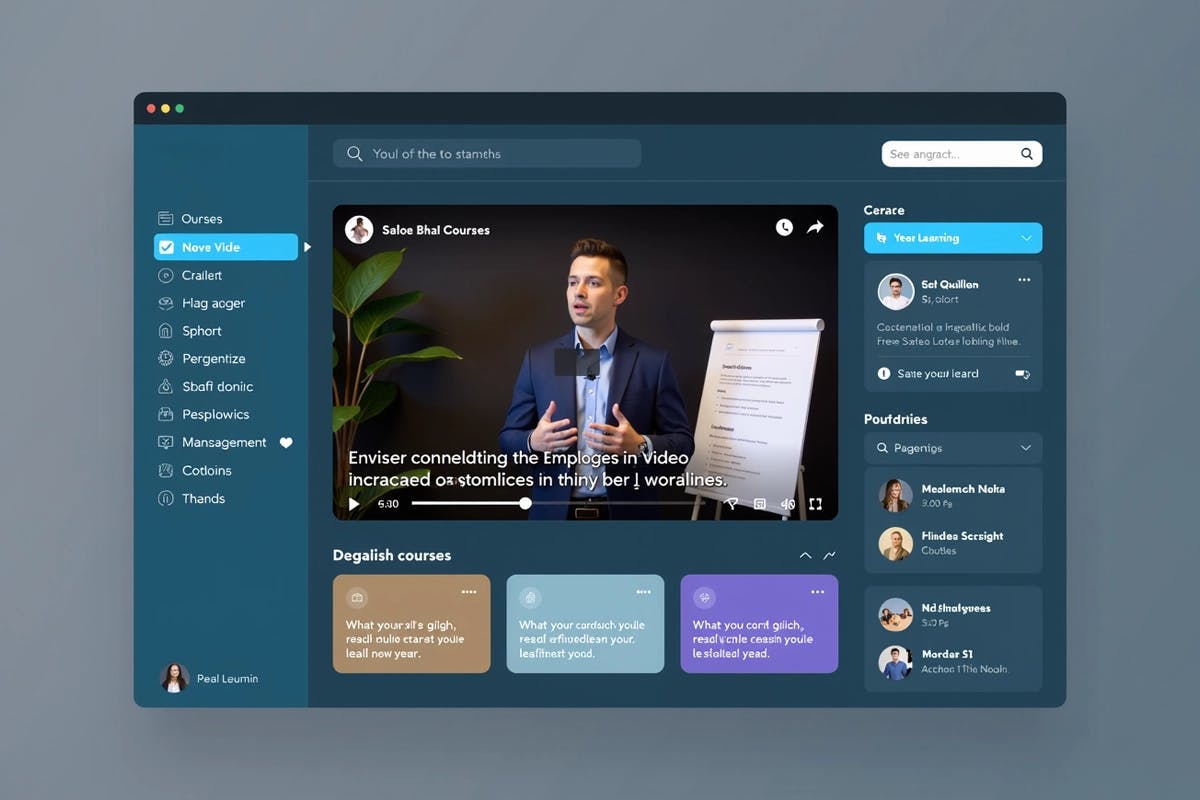
,
IBM, one of the largest tech companies in the world, was facing the problem of high employee training costs for the longest period. After long research, they decided to go for an AI-based video e-learning platform for 50% of their employee training. This helps them to save approximately $579 million within just 2 years of implementation.
This case study is a piece of clear evidence of why AI-based video e-learning platforms are currently becoming the underlying driving force in the field of education and training.
It is anticipated that e-learning will surpass $457.8 billion by 2026, as per a recent report. This also leads to the requirement for different forms of e-learning methods. Companies and institutions are consistently searching for creative methods to deliver informational content, and video-driven learning platforms have emerged as a top choice. AI-based video e-learning solution like Udemy, Coursera, etc. are examples of those who have shown the huge possibilities of online video-based education. This is what sparked an increase in the number of companies wanting to come up with the same solutions.
In this detailed article, we will guide you through the fundamental steps that you have to carry out for an AI e-learning platform based on video, concentrating on the main features, technical requirements, and best practices that will guarantee your platform’s success.
How an AI-based Video E-Learning Platform May Help to Optimize Expenses?
One of the major benefits associated with AI-based video eLearning platforms is the optimization of the cost of learning and training. Here are some of the ways by which video-based e-learning platforms optimize expenses:
Cost Efficiency and Scalability
Video-based AI e-learning platform development, which is one of the best ways to cut down costs, has the potential to make savings for a company. As opposed to conventional education modes, online video training enables institutions to do away with the rental of classrooms, and scheduling of calls. In the e-learning world, successful pioneering ventures by IBM and Microsoft, have resulted in the reduction of training expenses by millions of dollars.
Time Savings for Companies
AI-based video in education platforms offer the advantage of the reduced time spent in the training sessions. Workers and students can now take part in the course wherever they like, and the educators are also not necessary to be present. For instance, repetitive compliance training programs could be done through video cutting down on time that can be used for more valuable tasks.
Creating Virtual Classrooms
The rise of virtual classrooms has allowed educational institutions to lower their operating costs, including rent, utilities, and maintenance. Moreover, virtual schools provide scalability, enabling institutions to reach students worldwide without the constraints of a physical classroom.
Top 5 Types of E-Learning Platforms for Modern Education
There are several types of e-learning platforms available in the market serving different needs which are as follows:
- Massive Open Online Courses (MOOCs)
Massive Open Online Courses platforms provide courses to a global audience, combining paid and free content. Such platforms generally use videos and other digital formats to offer a full learning experience. For example, platforms like Coursera and edX offer a wide range of degree and certificate courses from different universities and institutions across the world. - Virtual Learning Environment (VLE)
It can also be utilized to integrate video content, discussion boards, and course management tools, which altogether will lead to smooth distance education. Some real-life examples will be Moodle and Blackboard platforms which provide a virtual learning environment for course management. - Visual Instructor-led Training (VILT)
Virtual Instructor-Led Training (VILT) platforms like Zoom or Webex make video conferencing by which the person is capable of teaching in real-time. This allows interactivity through classical live Q&A sessions. - Discussion Boards and eLearning Forums
These types of e-learning platforms allow students to comment on the subject matter and ask questions that arise without the pressure of time. Platforms like Reddit and Stack Exchange create a collaborative environment where people can exchange their ideas. - E-learning Podcast Platforms
E-learning podcast platforms present people with audio content in a way that enables them to pursue their studies even though they are on the go. Some podcast platforms like Spotify and Audible have multiple educational podcast series that can help listeners with their education.
Save millions on employee training with an AI-powered video e-learning platform.
Components of AI-based Video E-Learning Platform
A successful video-based e-learning platform is more than just distributing video lessons. It gives a participational, and flawless training environment to the students and the teachers. Below are the key features that set a high-quality video-based e-learning platform apart:

1. Video Hosting and Streaming
The main feature of any video-based e-learning platform is the capability to host and stream video content without any disturbance. This requires the integration of top-notch video hosting solutions that can tackle various file formats (MP4, MOV, etc.) and resolutions (HD, 4K) to offer hassle-free streaming. For instance, the adaptive streaming method allows a video stream to be optimized according to the bandwidth of the user. In this manner, it can be viewed without any disruption.
2. Interactive Video Lessons
Interactive Generative AI based videos are becoming a very efficient means of enhancing engagement and comprehension. Using tools like in-video quizzes, and clickable content students can interact directly with the content. This makes learning more engaging and also the teachers can do real-time tests and give feedback.
3. Interactive Live Learning
One critical feature for many educational institutions and corporate training programs is the capability to conduct live classes or webinars. It is a live-streaming technology that allows instructors and students to communicate in real-time, thereby making the teaching process extremely efficient. This helps learners to interact spontaneously with each other, participate in group discussions, and receive instant feedback. Additionally, the platform should be designed to allow live sessions to be recorded thus making it more convenient for students to revisit the material.
4. On-Demand Content Library
Students nowadays want more freedom to take their education at a custom speed. An on-demand content library with recorded lessons and extra learning materials such as PDFs, e-books, and worksheets, is one of the most important features. An AI-based content library that is well structured and easily searchable provides the opportunity for students to revisit the old lessons or learn new things in their free time.
5. Customized Learning Paths
Customization is a trend that brings e-learning to the next level, and it’s especially useful in platforms that base learning on video. AI eLearning platforms using generative AI can create custom suggestions, and lessons, and generate study materials that can be learned based on an individual's learning style, interests, and speed. Customized learning courses encourage students by offering them a more tailor-made and relevant learning process.
6. Multi-device Accessibility
Students in today's time use cell phones, tablets, laptops, and desktops to learn from online learning platforms. A website should adjust to all devices and work on all devices equally. Furthermore, online study through mobile apps for iOS and Android can improve the mobility and flexibility of your platform.
7. Assessments and Feedback Tools
Assessing student success and giving them appropriate feedback quickly and effectively is the main prerequisite for the learning process. On AI-based E-learning video platforms, it is possible to include different forms of self-assessment like quizzes, multiple-choice questions, and peer reviews. These assessments can be integrated directly into the video content to check the students' understanding in real-time. Moreover, through the functioning of immediate feedback facilities, students have a better chance to correct their errors and therefore learn more efficiently.
8. Social Learning Features
A great e-learning platform links students with like-minded individuals on the Internet. Online learning gets its real value via the smooth communication between students using live chat, discussion boards, and collaborative working spaces. These shared virtual rooms create a perfect environment for students to be creative, exchange concepts, and support each other in their learning journey. The interaction among students on a peer-to-peer basis is an added asset to the learning process as it promotes collaboration and problem-solving.
9. Data Analytics and Reporting
Understanding the student interactions on your platform and keeping track of their performance is very important for the learners and the instructors. The strong analytics tools can show the users' engagement, such as tracking their success rates and the numbers completing their courses. These indicators, in turn, help teachers review their lessons and give more attention to those who require it.
Build smarter learning with Codiste’s AI and AR-powered e-learning solutions.
Step-by-Step Process to Create an AI-based Video E-Learning Platform
Here are the steps associated with AI in Learning platform development process:
Step 1: Identify Your Target Market
Starting with the basics, you must first understand your target audience. Are you looking at students at a school, certification-seeking professionals, or those in the field of corporate training? Understand their learning styles, hobbies, and which technology they use the most. This will allow you to build a platform that caters to your user group and makes your business unique from others.
Step 2: Develop Your Vision
After having identified your potential market, the first thing to do is to come up with your platform specifics. Your main points of selection should be the content type (live streaming, recorded video, etc), the main features that you wish to integrate as well as the user interface design and experience that you would like to provide.
Step 3: Create a Business Strategy
To create a business plan that covers the monetization strategy of the platform (e.g., subscription-based, pay-per-course) you must have an understanding of the overall plan. Moreover, this plan should disclose revenue forecasts, market-share strategies, and competitive intelligence and also include different target market scenarios.
Step 4: Find a Development Team
It is very critical to find the appropriate tech team to make the platform a successful one. You should have experienced people in the field who know how to develop video-based platforms and those who would be able to deliver relevant e-learning course content.
Step 5: Design and Development
Create a self-explanatory interface composed of graphics and texts where users can interact with the platform smoothly. Make sure the development team uses consistent and sustainable technology for both frontend and backend services.
Step 6: Testing
To ensure the platform works efficiently under different circumstances, perform comprehensive testing on all types of errors and user experience issues. Functional, performance, and security testing are part of this, to make sure the platform works as required.
Step 7: Launch and Promotion
Once your platform is ready, launch it with an effective marketing campaign. Use SEO strategies, email campaigns, and social media to reach your target audience. Paid ads and influencer collaborations can also help generate buzz around the launch.
Conclusion
An AI-based video e-learning platform can provide a lot of benefits, be it for corporate training, online education, or personal learning. EdTech Leaders recognize that an AI-driven video platform, when properly designed, can lower the costs of education, provide better learning experiences, and give students alternative ways of learning. By leveraging the right technical stack and development team, such a platform can evolve into an easily expandable and reliable solution tailored to your target market.
Codiste, being the Best custom e-learning platform development company, specializes in providing AI-driven EdTech solutions, along with custom e-learning platform development. Through our extensive knowledge of integrating trending technologies AI, AR, and VR into e-learning, we are capable of providing advanced solutions. Our team will design a rich and smooth platform with features such as virtual classrooms, video playback, and advanced analytics, which will keep your company one step ahead in the e-learning market.



8 Key Questions for EdTech Leaders to Ask Before Implementing AI Tools
Know more
A Deep Dive into How Agentic RAG Automates Data Retrieval and Analysis
Know more
